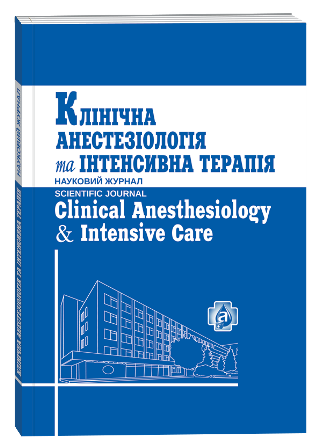HEMOSTATIC SYSTEM CHANGES AGAINST THE BACKGROUND OF THE DIFFERENT TREATMENT REGIMENS IN PATIENTS WITH ATHEROSCLEROSIS OF LOWER EXTREMITIES
DOI:
https://doi.org/10.31379/2411.2616.14.2.8Keywords:
obliterating atherosclerosis, thrombus formation, hemostasis.Abstract
Relevance. About 2-3% of the population and about 35-50% of people over 65 years suffer from obliterating atherosclerosis of the main arteries of the lower extremities. There are many known factors that potentiate atherosclerosis. Some of them are referred to as leading, such as hyperlipoproteinemia or hypertension, others to concomitant contributing to the defeat of the arteries. According to J.S.A. Fuchs include hypertension, hypercholesterolemia and smoking as major risk factors for atherosclerosis. They are less affected by obesity, diabetes, hypertriglyceridemia, sedentary lifestyle, stress Objective of the study. The purpose of this study is to evaluate the functional status of the vascular – platelet, coagulation and fibrinolysis of the hemostasis system and their disorders using low – frequency piezoelectric thromboelastography (LPTEG) in patients with obliterating atherosclerosis of the lower extremities on the background of treatment. Materials and methods. The initial state of the hemostasis system was evaluated in 90 patients undergoing treatment for obliterating atherosclerosis of the lower extremities in the Odessa Regional Clinical Hospital and MD Odreks. All patients underwent surgery in the amount of femoral-popliteal autologous bypass grafting. Adding a patient with OA to a particular group occurred randomly. Patients of both groups were examined in the same way, received the same intensive care regimen, indications for surgical intervention were set on the basis of the same criteria. Patients in the control (1st) group (45 patients) received analgesia during surgery and in the postoperative period based on epidural administration of bupivacaine, and their treatment regimen included enoxaparin 0.4 ml (40,000 anti-XA ME) 2 times a day subcutaneously into the anterolateral surface of the abdominal wall from the first postoperative day and pentoxifylline in / drip 200 mg twice a day for 7 days. Patients of the studied (2nd) group (45 patients) received analgesia during surgery and in the postoperative period on the basis of epidural administration of bupivacaine, also rivaroxaban 15 mg 2 times a day oraly on the first postoperative day and pentoxifylline in / drip 200 mg twice a day for 7 days was included in their treatment regimen. The dynamics of the state of the hemostatic system in both groups of patients with OA was evaluated using LPTEG in the first day before surgery and on the 3rd, 5th and 7th postoperative days. Results. Before surgery and the start of treatment in patients with OA, against the background of activation of the vascular – platelet link of hemostasis, significant structural and chronometric hypercoagulation with increased thrombin generation and depression of blood fibrinolytic activity are noted. Against the background of treatment in the 1st group, platelet aggregation tends to normalize and there are significant differences compared with the indicators before treatment in the 1st group, the vascular-platelet and fibrinolytic systems did not reach normal values before 7 days, but showed a significant downward trend the degree of manifestation of their violations. Against the background of treatment of the 2nd group, significant changes were observed towards normalization in all components of the hemostatic system according to the LPTEG technique. The state of the coagulation unit of the hemostasis system in patients with OA on the 7th day of therapy does not significantly differ from the norm, it is possible to note significant shifts towards hypocoagulation within the normal range. The fibrinolytic system on the 7th day of treatment does not statistically differ from normal indicators, it has significant positive dynamics compared to 1 day. The second group revealed a statistically significant normalization of all indicators characterizing the blood coagulation potential of the blood and the aggregation ability of platelets, as well as the indicator that is responsible for changes in the fibrinolytic blood system.
References
Effectiveness and Safety of Rivaroxaban Compared to Acenocumarol after Infrainguinal Surgical Revascularization / V. Ferreira [et al.] // Annals of vascular surgery. – 2019. – Vol. 55. – P.78–84.
Profundoplasty in treatment of patients with chronic lower limb ischaemia / A.V. Gavrilenko [et al.] // Angiology and vascular surgery. – 2019. – Vol.25 (3). – P.122-127.
Comparison of global estimates of prevalence and risk factors for peripheral artery disease in 2000 and 2010: a systematic review and analysis / F.G. Fowkes [et al.] // Lancet. – 2013. – Vol.382 (9901). – P.1329–1340
I.J. Kullo, T.W. Rooke. CLINICAL PRACTICE. Peripheral artery disease / I.J. Kullo, T.W. Rooke. // N Engl J Med. – 2016. – Vol.374 (09). – P.861–871
Anand S; on Behalf of COMPASS Investigators. Rivaroxaban in stable peripheral or carotid artery disease. Presented at the European Society of Cardiology Congress 2017, Barcelona, Spain; 2017







